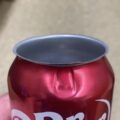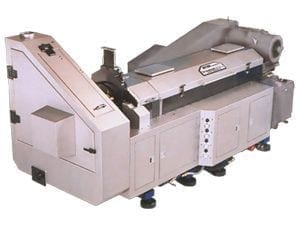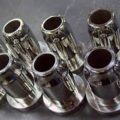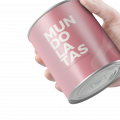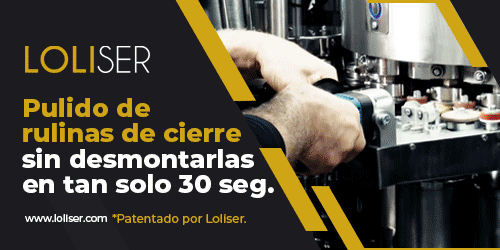CUP PRESS
As we continue with the audit, we observe the coil run. The coil is applied with a press lubricant, which is generally the same synthetic chemistry as the postlube, which has a high ester content. Once the coil is applied with the press, this lubricant is fed into the press by a set of feed rollers, the upper roller being generally made of spiral grooved rubber to improve lubricant distribution, and the lower roller is made of roughened stainless steel with shot blasting. In rare cases, the shot peening on the bottom roll may be excessive or the pneumatic feed roller pressure may be too high, resulting in the shot peening pattern becoming impregnated on the underside of the coil. This damage will appear on the bottom, usually on the outside edge of the coil or on the cups of the outer stations, and will cause short cans (peel-offs). If reducing the feed roll pressure does not eliminate this damage without coil slippage, then the likelihood is that the top roll occurred without a “crown” (where the center of the roll has a larger diameter) and may need to be reshaped accordingly.
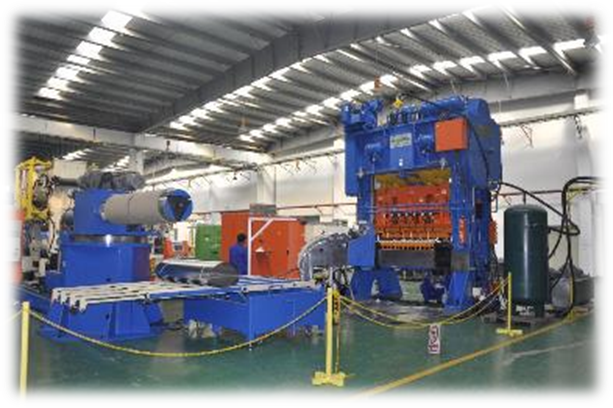
In some cases, the latest coil feeds use a feed pad that pneumatically indexes the coil. The press lubricant is the most important part of the system lubrication, what is not often understood is that the outside of the cup or bottom of the coil is purely for the cup metal forming process, and the inside of the cup or top of the coil is crucial for the DWI process in the Bodymaker. The speed of modern Bodymakers, generally in the region of 350 cpm, allows only a microsecond of application time in the redrawing part of the DWI process. The lubricant inside the press is the primary lubrication for punch penetration time, ester content and application.
The cup press consists of a set of blank dies and embossers mounted on a double-acting vertical press (this means that two processes are completed in the same location). The blanking shank stamps round or non-round discs from the immobilized coil leaving a web (like the excess fabric left by a tailor when cutting a suit of material). Years of computer-generated calculations have produced a cutting pattern that minimizes the web and subsequent waste. If the cutting edges of the blanking tools are burring or chipping, the resulting rough edge will form “whiskers” or fine aluminum chips that will be carried along the line contaminating the cups and causing a traumatic short can condition. This is the point where the entire line transitions to short cans (shedding). The resulting “whiskers” can be found in the cup evacuation lines, the cup handling system, the cup feed to the Bodymakers and the Bodymaker tool packs. The usual time for this damage to occur is either during installation or when producing the first blank due to the cutting edge being “too sharp”. Some experts have found that light sanding of the cutting edge producing 0.001″ wear tends to harden the edge for the first impact.
The draw stem continues forward and draws the blank into the shape of a cup. At this point in the production of the cup, if the blank is not held firmly in place and released slowly, the cup will wrinkle due to a “slipping” effect. Typical causes of this problem are low clamping pressure of the cupping cushion or excessive lubrication through a high weight of lubricant film that causes the bottom of the blank to be too slippery for the blank clamping mechanism to maintain a good grip. At the end of this process, the cup is unloaded from the tools with the help of an air strip assistant. If this strip assist is compromised due to the pressure being too low or excessive lubrication, this can result in the production of oval cups, as the cup does not release properly from the punch. It is important that, when setting up the press, the ducts of the press discharge system do not interfere with the downward blowing cup path, as damage will occur causing traumatic line detachment situations.

Once the cups are evacuated from the punch, they are blown into the aforementioned air-assisted discharge duct, which carries the cup to the conveying system. If the air pressure in this system is set too high, the cups will be damaged by hitting the walls of the cup conveying system, which will also result in short cans and/or oval cups. The production of oval cups tends, if severe enough, to cause problems in locating the cup feed to the bodymaker punch and, subsequently, incorrect cup feed (this will register on the bodymaker sensors as “no visible can”).
We mentioned earlier the importance of checking for coil damage at the uncoiler and lubricator discharge. This is also true for damage that may be caused by the press on the steel feed roll or during travel through the press. If a traumatic short can condition is in progress and the short can troubleshooting diagram indicates such possible damage, it is helpful to remove 5 meters of coil and carefully examine the bottom to see if any damage has occurred in this area.
The produced cup should have minimal or no wrinkles. If you can feel wrinkles when you run your fingernail over them, you will probably produce “bleedthrough”, which is an aesthetic condition where the smoothed aluminum shows through as translucent white or pastel-colored inks as black lines. The valleys of the wrinkles produced are ideal spots for the free aluminum produced in the cup making process to deposit, and this deposit will subsequently smooth out on the can surface in the Bodymaker stage. Reducing the lubrication or increasing the pressure of the draw cushion will reduce or eliminate wrinkles and produce a smoothing of the wall on the top of the cup (this will appear as a shiny area on the top of the cup). This wall smoothing should not exceed 10% of the total wall height. The matching gap, if too large, can also cause these wrinkles, as the metal is allowed to move freely as it changes shape in the blanking and drawing stages. Control is important in the process.
Due to the metallurgical qualities, the cup produced will show a slight “earring”, which are areas around the top of the cup that are higher than the overall circumference. If the earring is excessive (generally if it is more than 3 mm above the average), loss of quality will occur in the can. An earring with a scratch or lamination just below will indicate scrap damage that can be resolved by cleaning the press tools and canisters. If the earring is on all cups and oriented at 45° or 90° to the grain of the stock, then the coil should be replaced, as the quality of the coil is probably the culprit.
The radius region of the cup should be carefully investigated, as sometimes, due to problems with the cupping cushion, the cup will be formed by plastic deformation at an uneven rate, resulting in thinning of the metal. This is usually seen as a white line just above the radius. The resulting thinning of the metal will cause traumatic short can conditions.
Finally, any marks, scratches or dents in the produced cup that can be felt by running the fingernail over it will cause problems in production and the cause must be located and removed.
CUP CONVEYOR SYSTEM:
The cup conveying system generally consists of an air-assisted elevator and a cup conveying bed. In some cases, the cup transport bed will be replaced by a mechanical conveyor belt. As with the cup discharge system, if the air pressures are not balanced correctly, it is inevitable that the cups will be damaged and short cans will be produced. It is always advisable to check the conveying system for signs of contamination, either from external contaminants, such as air extractors, or whiskers generated in the pressing process.



